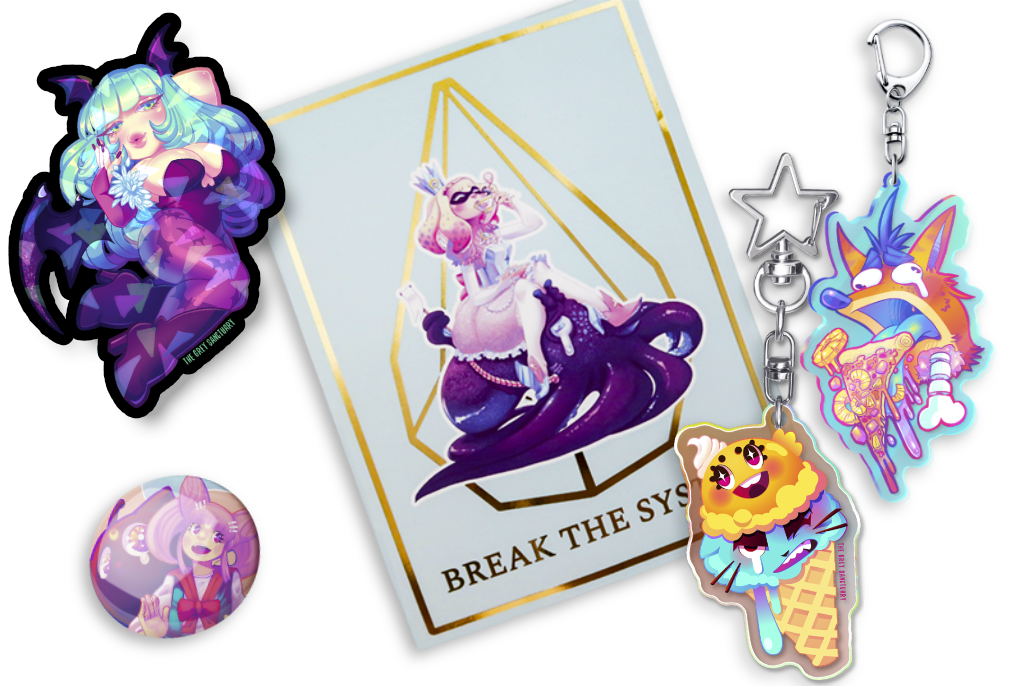

Little Cathedral Blog
Let’s Talk About Art Licensing & Royalties – Part 1
Licensing is anything related to granting the right to use your artwork, design, or asset to someone who is looking to generate revenue with your intellectual property or derivative work while earning you royalties. These can be found in specific contracts with agreed fees, time frames, and particular individuals when downloading or buying fonts, brushes, digital assets for streaming, and more.
You should consider the value of the potential of your work when estimating the value of “exclusive”, “unlimited”, or “all rights” agreements.
Graphic Artist Guild Handbook Pricing & Ethical Guidelines 14 Edition
What Is Licensing?
It is a contract or agreement between the licensor and a licensee, where the licensor grants permission to the licensee to use their intellectual property, an asset, brand, trademark, or patented technology in products (digitally or physically) for commercial purposes.
What Are Royalties?
It’s a type of passive income that compensates for the artist’s contribution and value of their works while allowing others to reproduce the intellectual property or assets in exchange for royalty payments without the need to produce new pieces (if applicable), and still retain legal ownership of the work. It can be considered as an additional type of earning for a living. This type of business is full of opportunities to generate revenue in new markets and expand to broad audiences.
It is important to mention that royalties are negotiable, if no advance or fair compensation is offered, the artist can ask for a higher royalty compensation. A successful deal can be achieved if the artist carefully evaluates the project’s scope by asking the client or licensee for details. Royalties can be carried out in negotiations with retailers (sells products directly to consumers) or wholesalers (sell products in bulk to businesses).
Licenses don’t revolve around pre-existing work only, it can also be of the creation of a new artwork or design. If a licensee requests such creation, the artist is entitled to an additional separate payment and should be paid in advance for the soon-to-be licensing work.
Basic Standard
Let’s remember that the artist, according to the copyright law, is the creator and has ownership of every artistic or literary work, which additionally can divide their bundles of rights and sell them such as:
- Create a derivative work from an existing one.
- The ability to distribute publicly the work.
- And the right to reproduce the work.
According to the copyright law of the USA, the sale of reproduction rights of the sale of the original piece is not included in the original sale of said artwork. This means that the reproduction of the original piece to generate an income must be done within a separate transaction with an agreement.
Artists need to learn to negotiate a good royalty deal when licensing their artworks with potential licensees as a crucial step to maximize profits. On the contrary, the artist will live awfully compensated and deprived of thriving if they charge the same price between extensive/all rights and limited rights due to mistakes and abuses. The artist is not only responsible for specifying the types of granted rights of usage (reproduction) with their requirements and restrictions, creating appropriate negotiations, but also identifying the client’s needs when being requested for a right license.
Types Of Parties Involved
- Licensor – Artist that grants the right to use the artwork or intellectual property.
- Licensee – Client or entity that has been granted the right to use the intellectual property by the artist.
- Licensing Consultant – They help artists identify suitable companies for them by studying them with effective approaches and finding appropriate agents.
- Licensing Agent – They have a vast network of directors, companies, and agencies that can help elevate the artist’s journey and seal successful deals. They are responsible for negotiations, marketing, billings, etc. Because of their expertise, they are also considered an investment and may take a commission profit for each deal they acquire for the artist.
Type Of Agreements
- Exclusive Agreement – The artist grants the right(s) to use or commercialize the design or product with a license for a specific licensee. This agreement can become more restrictive and demand a higher rate, but probably has less potential for multiple incomes.
- Non-Exclusive Agreement – The granted license or licensees can have multiple licensees using it simultaneously for various purposes. It can be considered less lucrative but can expand to a broader target audience and generate multiple incomes.
- Limited Edition Agreement – Grants the right to reproduce a limited quantity of specific work for a single application, especially if it’s related to promotional material, marketing, or special events.
Types of Degree From The Exclusive Licenses
- Perpetuity – Grants unlimited use of the artwork or design to a licensee.
- Specific Markets/Products – Grants the right of usage of the artwork solely to a specific licensee in a particular market or product.
- Specific Time Frame – Grants the right of usage to a specific period, ranging to several hours, days, months, or years, or the life cycle of the product. Once the time frame expires, other competitors may request the license.
Important Detail About Registration
Before proceeding with any type of negotiation with your art licensing and royalties, make sure to register your artwork or designs with the appropriate legal department for better and extended protection against any dispute or copyright infringement claims.
Factors That May Impact Royalty Rates
Although it can vary, especially due to location, demand, and jurisdiction’s law, the most important factors are the ones in bold.
- Royalty rate
- Contract Terms
- License Exclusivity
- Development stage
- Performance metrics
- Artist’s Reputation/Popularity
- Intellectual property of the artist
- Demand
- Market size
- Industry rates
- Type of product
- Specified quantities
- The party or entities involved
- Marketing/Promotion strategies
Is It Trustworthy?
The thing about freelance, whether it be signing a contract, developing a project, or negotiating royalties, it is all about an act of good faith, based on transparency, ethics, and open and honest communication between both parties. It is recommended that during the negotiation of licensing and royalties, the artist can monitor the sales, as part of the contract, by requesting sale data.
Current data indicates that reuse, more extensive use, use in additional markets, or international uses receive additional compensation.
Graphic Artist Guild Handbook Pricing & Ethical Guidelines 14 Edition
That’s it for now with the first part. You can read the second part about Art Licensing and Royalties to dive into more complex and technical aspects when negotiating with potential licensors. Also, if you are interested, I wrote The Importance Of Creating A Contract Part 1 and Part 2, how to build contracts for Work For Hire, Commission, Art Licensing & Royalties and Estimate, Invoice, and Receipt.
NOTE: I want to emphasize that this post is for educational purposes, legal information is not the same as legal advice. Therefore, it is recommended that you consult with a lawyer to obtain more professional guidance in the legal field.
Resources
Graphic Artist’s Guild. (2013). Graphic artist’s guild handbook of pricing and ethical guidelines (14th ed.). Graphic Artists Guild.
Brophy, M. (2012, April 26). What to charge for art licensing – royalties advances and flat fees. Maria Brophy. https://mariabrophy.com/art-licensing/what-to-charge-for-art-licensing-royalties-advances-and-flat-fees.html
QueryLetter.com. (2020, November 10). How do advances and royalties work?. QueryLetter.com. https://www.queryletter.com/post/how-do-advances-and-royalties-work
Stim, R., & Farkas, B. (2023, May 18). Licensing artwork: Negotiating and Monitoring Royalty payments. www.nolo.com. https://www.nolo.com/legal-encyclopedia/licensing-artwork-negotiating-monitoring-royalty-payments-30093.html
Cook, B. (2024, November 15). Royalty payments: A comprehensive guide. Tipalti. https://tipalti.com/blog/royalty-payments/
Salunkhe, R. (2024, November 27). A guide to art royalties and licensing for creative success. Photo To Portrait: Hand-Painted Portraits By Pro Artists. https://www.whataportrait.com/blog/art-royalties-and-licensing-guide/
Thank You For Reading!
If you like my work and documentation and wish to see more, please consider contributing to my growth and hard work with more exploration, investment, and website maintenance.











Leave a Reply